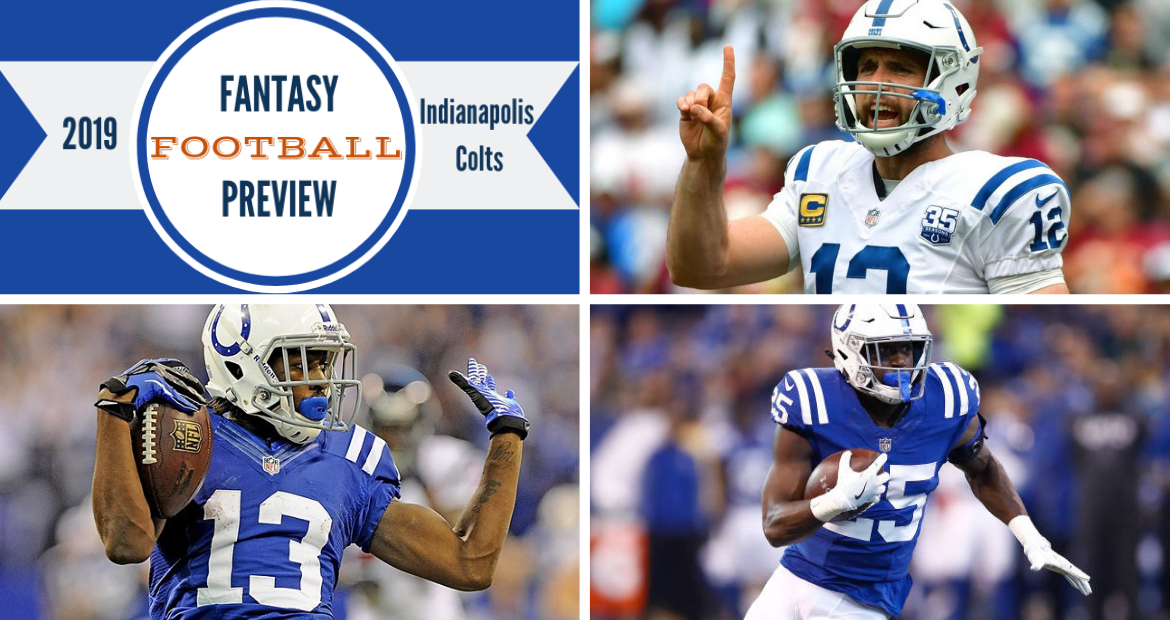
Fitz on Fantasy: 2019 Indianapolis Colts Buying Guide
With the preseason nearing, TFG fantasy expert Pat Fitzmaurice is breaking down the prospects for all 32 teams, beginning with the AFC South. Click here to read about the Titans and check back daily for new team previews. On to Indianapolis…
The degree to which public confidence has swung on Andrew Luck in the last calendar year is remarkable. There was so much fretting about Luck’s recovery from a torn labrum last summer, you’d have thought his throwing arm had turned gangrenous. Now, Luck is the consensus No. 2 quarterback behind Patrick Mahomes.
Luck proved his arm fitness last year by hoisting 639 passes, the second-highest total in the league behind Ben Roethlisberger’s 675. Luck also ranked second in the league with 39 TD passes, one off a career high, and averaged 287.1 passing yards per game.
But was Luck’s arm back to normal? His completion percentage of 67.3% was by far a career high, but his average depth of target was 8.1 yards, a career low. Maybe reduced arm strength was the reason he was throwing shorter passes. The encouraging thing is that this phenomenon was more pronounced at the beginning of the season. Over the first six games of the season, Luck averaged 48 pass attempts per game but only 6.2 yards per attempt. So maybe Luck’s arm got stronger as the year went on and he felt better about trying to drive the ball downfield. In any case, the soundness of his shoulder is no longer a concern for prospective buyers.
I won’t buy Luck in a conventional 1QB league simply because I don’t pay Gucci prices for quarterbacks in such leagues. Superflex and 2QB leagues are another matter, but I have Luck ranked QB4 behind Mahomes, Deshaun Watson and Aaron Rodgers. Luck did some running earlier in his career, which added to the fantasy appeal, but he didn’t run much last year. It’s hard to tell whether he’ll start running more, or if he’s transitioning into a more inert phase of his career. That’s one mild concern. Another is that the Colts won’t throw as much this season since they should be one of the top teams in the AFC and are apt to see a lot of run-friendly game scripts. Those are minor nits though, and they’re only being picked here to help separate the top QBs.
Jacoby Brissett will earn peanuts as Luck’s backup for one more season before getting rich in free agency next March. Brissett performed capably when Luck was sidelined for all of 2017 and would at least be stream-worthy if anything were to happen to Luck in 2019.
One of the most stable assets in our game, T.Y. Hilton has exceeded 1,000 yards in five of the last six seasons, falling 34 yards short the year Luck was on the shelf. He’s averaged 75.0 yards per regular-season game over seven years, but if you take out his rookie season (when he started just one game) and the 2017 season (with no Luck), Hilton’s per-game average jumps to 81.4 yards. Uncle Hilty picks up his yardage in meaty chunks, averaging 16.0 yards per catch for his career.
Hilton isn’t a prolific TD scorer. He’s averaged 5.7 touchdowns a season, and his career high is seven. But as reliably as he picks up yardage, the modest TD counts are a small quibble. Like the higher-end hotels bearing his name, Hilton offers an appealing combination of comfort and luxury. Conrad Hilton would be proud.
Devin Funchess arrived in March via free agency, agreeing to a one-year deal that could be worth up to $13 million. That seems like an exorbitant sum for Funchess, a big (6-4, 232) possession receiver who runs like he’s carrying furniture. The only year he was any sort of fantasy asset was 2017, when Carolina was scratching the felt at wide receiver and Funchess had 63 catches for 840 yards and eight touchdowns almost by default. It’s hard to see Funchess being fantasy-relevant for the Colts this year barring a spate of injuries to other pass catchers.
The Colts took Ohio State WR Parris Campbell late in the second round of this year’s draft, hoping he’ll be mmm good. He has 4.31 speed, but he probably won’t be the sort of vertical receiver that Hilton is. Campbell had an aDOT of just 4.5 yards in his final year at OSU. That’s largely attributable to Urban Meyer’s system, and it doesn’t necessarily mean Campbell is destined to be a short-area receiver. But Campbell is John Wick-level dangerous with the ball in his hands, so it makes sense to get him some high-percentage targets close to the line of scrimmage and let him do his thing. The public is much higher on Campbell than the experts are. His average draft position is WR50; his expert consensus ranking is WR63. I’m with the experts on this. There are quite a few viable targets in Indianapolis these days, so it’s hard to see Campbell carving out a substantial role as a rookie.
(Everyone realizes that the Colts can now deploy a Parris-Hilton WR combo, right? OK, let’s just move on.)
After returning from a hamstring injury in mid-October, Marlon Mack scored 10 TDs in his last 11 regular-season games and averaged 79.5 rushing yards over that stretch. He also steamrolled the Texans for 148 yards and a touchdown in the wild-card round of the playoffs. Mack’s touch counts increased as the season went on, and he was able to do damage against pretty much every opponent he faced except Jacksonville, which held him to 20-56-0 in two games.
One of the big draws with Mack is the offensive line he runs behind. The Colts ranked fourth in Football Outsiders’ adjusted line yards metric last season, and all five starting linemen are back for another season. If you’re into offensive line play, watching guard Quenton Nelson bear-maul hapless defenders in his rookie season surely put a smile on your face. Mack probably enjoyed it, too.
Fourth-round draft pick Nyheim Hines quickly settled in as Indy’s passing-down back, catching 63 balls for 425 yards and two TDs as a rookie. He didn’t offer much as a runner, however. A 78-yard rushing day against Oakland was the only time he had more than 50 yards on the ground. Hines is a reasonable depth piece in PPR leagues, but he isn’t all that valuable in standard or half-point-PPR formats because even if Mack were to get hurt, Hines probably wouldn’t be the primary early-down back. That role would likely fall to either Jordan Wilkins, who’s coming off a decent rookie season, or Spencer Ware, a useful contributor to the Chiefs at one time.
Colts tight ends accounted for 26.7% of team targets last year, the fourth-highest percentage in the league behind only the three teams with TE mega-studs (Chiefs, Eagles, 49ers). With Jack Doyle playing six games, Eric Ebron was the prime beneficiary of Luck’s TE largesse, setting new career highs in receptions (66) yardage (750) and touchdowns (14, including a TD run vs. the Jaguars in Week 10). But what happens if Ebron and Doyle are both healthy? Well, let’s do some quick back-of-the-envelope calculations.
If we project Luck for 600 pass attempts and the Indy tight ends for a 25% target share. That’s 150 targets to be spread around. Let’s say Luck completes 70% of his throws to tight ends. (His completion percentage to TEs is destined to be higher than his completion percentage to WRs, and his completion percentage on Doyle targets the past few years has been well above 70%.) That works out to 105 completions to tight ends. Maybe that means 50 catches for Doyle, who figures to play the most snaps because he’s the best blocker, 45 catches for Ebron and 10 catches for Mo Alie-Cox, who had seven catches last year and has been getting rave reviews at OTAs. Doyle might be the favorite to lead the group in receptions, but he has a career average of 8.6 yards per catch and hasn’t had more than five TD catches in a single season. Ebron tends to do greater damage with his receptions.
Maybe it’s inevitable that Doyle and Ebron cannibalize each other’s numbers. But if one gets hurt, the other could become a high-end TE, as we saw with Ebron last year while Doyle was bedeviled with injuries. In fact, Doyle is still working his way back from hip surgery, and Ebron himself had core muscle (read: groin) surgery. Ebron is slightly overpriced coming off the big season, so I’d be more apt to buy Doyle at his current cost.
Before we take our leave of the Colts, a quick word about stacking. Even the biggest fish among DFS players – the flounders and groupers – know about stacking, but it can be a viable strategy in season-long leagues, too. Stacking triplets from one team is an aggressive way to bet on a strong offense, and the Colts are the sort of team that could make it work.
I tried a stacking strategy in two season-long leagues last year, drafting Alvin Kamara, Michael Thomas and Drew Brees in the highly competitive FantasyPros Invitational, and drafting Todd Gurley, Brandin Cooks and Jared Goff in a home league. The Saints stack got me off to a 6-0 start but faded down the stretch, leading to an early playoff exit. The Rams stack took me to the championship game, where I had to face a powerhouse opponent without the injured Gurley and went down hard. Overall, I was satisfied with the results.
You could conceivably land Hilton late in the second round, Mack early in the third and Luck a few rounds later. I think the key to a stacking strategy in a season-long league is doing it with a team that has a glass-eating offensive line, and the Colts have one of the best. Try it with a team that has a flawed offensive line, and your stack becomes a wobbly Jenga tower.
| PLAYER | FITZ RANKING | ECR | ADP | ADVICE |
| Andrew Luck | QB4 | QB2 | QB2 | A top option |
| Marlon Mack | RB14 | RB14 | RB16 | Dig in |
| Nyheim Hines | RB43 | RB43 | RB45 | Only in PPR |
| T.Y. Hilton | WR9 | WR9 | WR11 | Gimme some |
| Parris Campbell | WR64 | WR63 | WR50 | Non merci |
| Devin Funchess | WR56 | WR50 | WR53 | Limited opps. |
| Eric Ebron | TE11 | TE7 | TE7 | Too pricy |
| Jack Doyle | TE16 | TE15 | TE20 | Only if cheap |
ADP = Average Draft Position ECR = Expert Consensus Ranking



